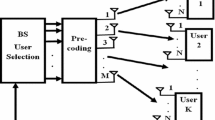Abstract
One-bit quantization of signal-to-interference-plus-noise ratio is discussed in literature for user scheduling in homogeneous network where users are assumed to have equal signal-to-noise ratio (SNR). It is mentioned in literature that 1-bit quantization with fixed quantization threshold does not achieve multiuser diversity. Moreover, the system sum-rate achieved by this lags significantly behind that of full feedback scheme. Two multi-bit quantized feedback scheduling schemes are proposed for broadcast network with heterogeneous users experiencing different channel statistics. It is presented that these two schemes with fixed optimum quantization thresholds profit from the diversity provided by independent and identically distributed channels. Moreover, proposed optimistic multi-bit quantized scheduling scheme achieves higher system sum-rate than the proposed multi-bit quantized scheme by addressing the limitations of the later one. The optimum quantization thresholds depend on the number of transmit antennas and system SNR. Moreover, these multi-bit quantized feedback scheduling schemes also ensure user fairness. Simulation results are presented to support the numerical analysis.

















Similar content being viewed by others
References
Telatar, E. (1999). Capacity of multi-antenna gaussian channels. European Transactions on Telecommunication, 10, 585–596.
Caire, G., & Shamai, S. (2003). On the achievable throughput of a multiantenna gaussian broadcast channel. IEEE Transactions on Information Theory, 43, 1691–1706.
Vishwanath, S., Jindal, N., & Goldsmith, A. (2003). Duality, achievable rates and sum-rate capacity of gaussian MIMO broadcast channel. IEEE Transactions on Information Theory, 49, 2658–2668.
Weingarten, H., Steinberg, Y., & Shamai, S. (2006). The capacity region of the Gaussian multiple-input multiple-output broadcast channel. IEEE Transactions on Information Theory, 52, 3936–3964.
Wong, K. K., Murch, R. D., & Letaief, K. B. (2003). A joint channel diagonalization for multi-user MIMO antenna system. IEEE Transactions on Wireless Communications, 2, 773–786.
Jindal, N., Rhee, W., Vishwanath, S., Jafar, S. A., & Goldsmith, A. (2005). Sum power iterative water-filling for multi-antenna gaussian broadcast channels. IEEE Transactions on Information Theory, 51, 1570–1580.
Bayesteh, A., & Khandani, A. (Sept. 2005). On the user selection for MIMO broadcast channels. In Proceedings of the IEEE international symposium information theory (pp. 2325–2329). Adelaide, Australia.
Jindal, N. (Nov. 2005). MIMO broadcast channels with finite rate feedback., In Proceedings of IEEE global communications conference (pp. 1520–1524).
Swannack, C., Uysal-Biyikoglu, E., & Wornell, G. W. (Sep. 2005). MIMO broadcast scheduling with limited channel state information. In Proceedings of annual Allerton conference on communication, control, and computing.
Jaewoo, S., & Cioffi, J. M. (2009). Multiuser diversity in a MIMO system with opportunistic feedback. IEEE Transactions on Vehicular Technology, 58, 4909–4918.
Xu, Wei, & Zhao, Chunming. (2010). Two-phase multiuser scheduling for multiantenna downlinks exploiting reduced finite-rate feedback. IEEE Transactions on Vehicular Technology, 59, 1367–1380.
Wunder, G., Schreck, J., & Jung, P. (2012). Nearly doubling the throughput of multiuser MIMO systems using codebook tailored limited feedback protocol. IEEE Transactions on Wireless Communications, 11, 3921–3931.
Min, M., Kim, D., Kim, H., & Im, G. (2013). Opportunistic two-stage feedback and scheduling for MIMO downlink systems. IEEE Transactions on Communications, 61, 312–324.
Pattanayak, P., Roy, K. M., & Kumar, P. (2015). Analysis of a new MIMO broadcast channel limited feedback scheduling algorithm with user grouping. Springer Wireless Personal Communications, 80, 1079–1094.
Naeem, M., & D.C., Lee. (2014). A joint antenna and user selection scheme for multiuser MIMO system. Applied Soft Computing, 23, 366–374.
Pattanayak, P., & Kumar, P. (2015). A computationally efficient genetic algorithm for MIMO broadcast scheduling. Applied Soft Computing, 37, 545–553.
Kountouris, M., Slzer, T., & Gesbert, D. (2008). Scheduling for multiuser MIMO downlink channels with ranking-based feedback. Springer EURASIP Journal on Advances in Signal Processing, 2008(5), 1–14.
Xu, W., Cao, Y., & Zhao, C. (2013). Capacity analysis of MIMO group-broadcast channels with time-division scheduling. Springer Wireless Personal Communications, 68(4), 1331–1350.
Al-Ghadhban, S. (2014). Opportunistic round robin scheduling for V-BLAST systems over multiuser MIMO channels. Springer EURASIP Journal on Wireless Communications and Networking, 2014(1), 1–11.
Wang, F., Bialkowski, M. E., & Bialkowski, K. S. (2013). Successive user scheduling schemes for a multiuser MIMO system employing generalized channel inversion. Springer Wireless Personal Communications, 68(2), 401–416.
Sharif, M., & Hassibi, B. (2005). On the capacity of MIMO broadcast channels with partial side information. IEEE Transactions on Information Theory, 51, 506–522.
Viswanath, P., Tse, D. N. C., & Laroia, R. (2002). Opportunistic beamforming using dumb antennas. IEEE Transactions on Information Theory, 48, 1277–1294.
Vicario, J. L., Bosisio, R., Anton-Haro, C., & Spagnolini, U. (2008). Beam selection strategies for orthogonal random beamforming in sparse networks. IEEE Transactions on Wireless Communications, 7, 3385–3396.
Zhang, W., & Letaief, K. B. (2007). MIMO broadcast scheduling with limited feedback. IEEE Journal on Selected Areas in Communications, 25, 1457–1467.
David, H. A. (1981). Order statistics (2nd ed.). New York: Wiley.
Author information
Authors and Affiliations
Corresponding author
Rights and permissions
About this article
Cite this article
Pattanayak, P., Kumar, P. Quantized feedback MIMO scheduling for heterogeneous broadcast networks. Wireless Netw 23, 1449–1466 (2017). https://doi.org/10.1007/s11276-016-1232-0
Published:
Issue Date:
DOI: https://doi.org/10.1007/s11276-016-1232-0




